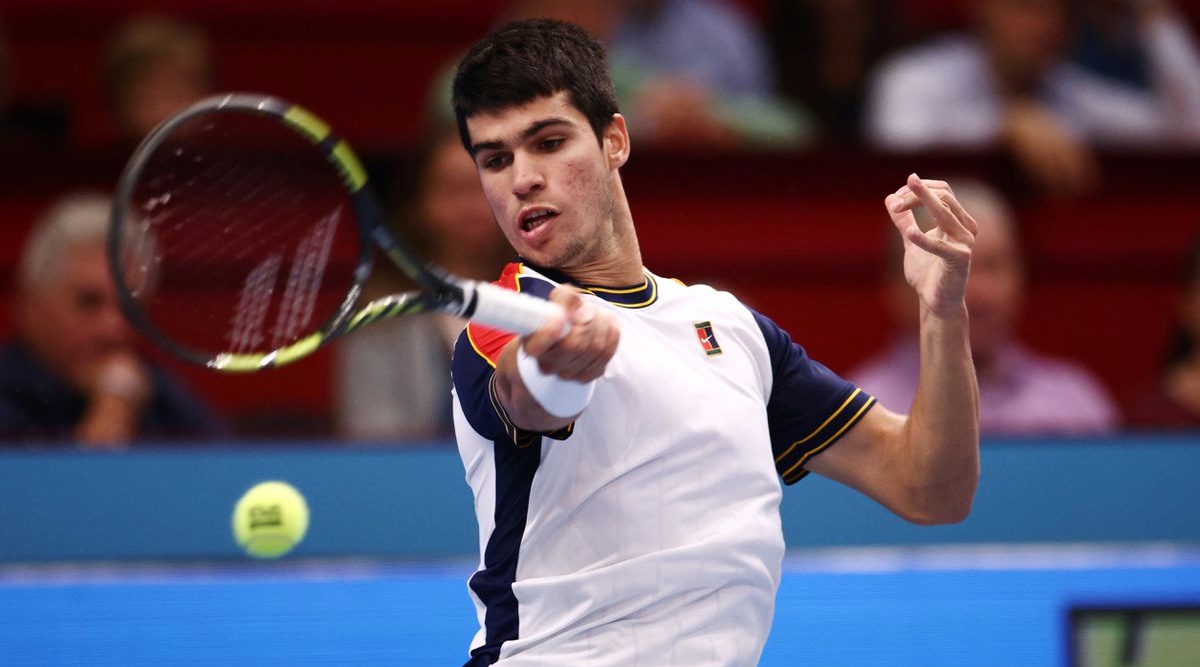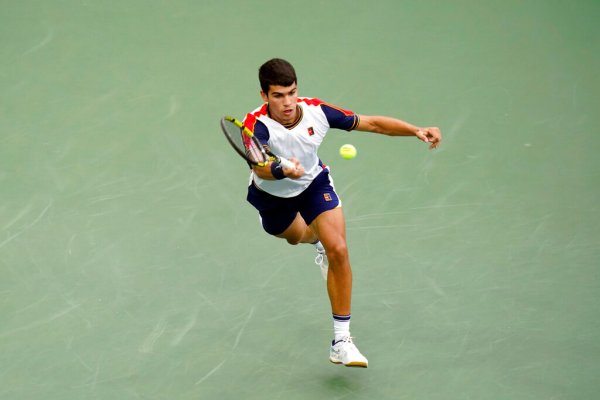 Spain's Carlos Alcaraz in action at the Erste Bank Open. (Reuters/FILE)
Spain's Carlos Alcaraz in action at the Erste Bank Open. (Reuters/FILE) By Christopher Clarey
The rowdy tennis academy Christmas party was underway in the adjoining room. But Carlos Alcaraz was sitting calmly at a table surrounded by trophies and talking about the beauty of training in this place that was remote, relaxed and “tranquilo.”
It was hard not to detect a metaphor as the dance music pounded through the wall.
Alcaraz, a dynamic and genial Spaniard who is one of the most exciting next-generation talents in sports, will have to keep blocking out a great deal of commotion to fulfill his justifiably big dreams.
At 18, he is drawing comparisons to Rafael Nadal, his compatriot, at the same age, even if their styles are dissimilar and Alcaraz has a photo of Roger Federer, not Nadal, in his room. But like Nadal back in the day, Alcaraz is a genuine prodigy: already ranked 31st on the tour and seeded at that spot at the Australian Open, where he has advanced to the third round despite contracting the coronavirus in November and skipping all the lead-in tournaments.
“I think he’s got greatness written all over him,” said Paul Annacone, who coached Pete Sampras and Federer, now works with the top-ranked American Taylor Fritz, and is generally wary of praising players too soon.
 Carlos Alcaraz, of Spain, in action during the fourth round of the U.S. Open. (AP/FILE)
Carlos Alcaraz, of Spain, in action during the fourth round of the U.S. Open. (AP/FILE) But Alcaraz, the youngest player in the men’s draw in Melbourne, can certainly carry you away with his airborne, all-court brand of tennis.
At 6-foot-1, he is the same height as Federer and Nadal, yet considerably shorter than the leaders of the new wave — Daniil Medvedev, Alexander Zverev, Stefanos Tsitsipas and Matteo Berrettini — all of whom are 6-foot-4 or taller. But on the court, he does not look like an underleveraged underdog.
His game is a bewitching blend of quick-strike power, abrupt changes of pace, and quicksilver movement resembling that of a gymnast as he slides into splits in the corners and maintains his body control even in extreme positions.
“His game is electric,” Annacone said. “It’s a bit like lightning in a bottle. He’s got that fast racket, like Andre Agassi did, and he’s got the fast feet like Rafa does. He can play up on the baseline, and he can back up when he needs to. So, he has a lot of things so naturally already at 18 and he’s already 30 in the world, so I just can’t imagine how good he’s going to be in two years if he stays healthy.”
Alcaraz is coached by Juan Carlos Ferrero, a self-contained Spaniard and former world No. 1 whose calm gaze seems well-suited to the stark, long-horizon landscape near Villena in southeastern Spain full of medieval fortresses and open space. Ferrero grew up near here and now is one of the owners of the JC Ferrero Equelite Sport Academy, where Alcaraz boards and trains.
“The key this year is to keep working well and not think for a moment that the hard work is already done,” Ferrero said. “But knowing Carlos and the values he and his family have, I’d be very surprised if he lets success go to his head.”
Alcaraz was born into a tennis family in El Palmar, a suburb of Murcia, about an hour’s drive from Villena. Alcaraz’s paternal grandfather, also named Carlos, helped transform a hunting club in El Palmar into a club with tennis courts and a swimming pool. Alcaraz’s father, also named Carlos, learned to play the game, inspired by the achievements of Manuel Santana, Spain’s first men’s Wimbledon champion, who died in December.
But despite becoming one of the best players in Spain, Alcaraz’s father lacked the money to pursue a professional career for long: stopping at age 20 and becoming a tennis coach and administrator at the club. Alcaraz, the second of four sons, has taken the family passion to the next level.
Alcaraz spends weekdays at the academy and returns to El Palmar on weekends. “I once planned to remain at home, but it was hard to find practice partners,” he said. “I think if I would have stayed in Murcia, it would have taken longer for me to rise. In Murcia, there are more distractions. Lots of friends. Going out at night. Here in the academy I don’t have that.”
Ferrero appreciates that Alcaraz’s father does not interfere with his coaching. Ferrero, nearly as lean at age 41 as he was in his prime, won the French Open and reached No. 1 in 2003 before Federer and Nadal took command. He has been where Alcaraz wants to get.
“I’m still quite young, and I’m going through a period where everything is new for me, and Juan Carlos already has lived through this, and he can really bring me that experience that other coaches cannot,” Alcaraz said. “He lived it from the inside.”
And what tip from Ferrero has proved the most helpful so far?
“Above all, he told me not to be in a hurry,” Alcaraz said. “That I’m going to get the experience and play the tournaments and learn the ropes, and that there’s no need to get ahead of the process. I need to live all these moments and not be in a hurry for the results right away because I’m going up against the best in the world for the first time in all these tournaments that I’m playing for the first time. And I need to enjoy it and respect it and acquire the experience I need to have a clear vision of it all.”
That has not stopped coach and pupil from announcing lofty goals for 2022 that include securing a spot in the top 15. Alcaraz made clear Monday that he would prefer making the top eight and qualifying for the season-ending ATP Finals in Turin, Italy.
What is obvious as Alcaraz prepares to face the No. 7 seed Berrettini in the third round Friday in Melbourne is that the best players in the world are already nervous. He might not have a driver’s license, but he does have game.
Getting stronger is also part of the plan. Alcaraz spent much of this offseason the same way he spent much of last offseason: doing strength and conditioning work to prepare himself for best-of-five-set tennis and a busy schedule. Going sleeveless in Melbourne was partly a link to Spanish tennis stars past (like Nadal and Carlos Moya) but also an expression of confidence in his more muscular build.
“We know that this year I’m going to have to play some long matches, and so it’s important to feel strong physically,” Alcaraz said. “Knowing that you can hold up is very important.”
Ferrero likes the comparison of Alcaraz to a car with a powerful motor that requires a chassis that is sturdy enough to support it.
“You can have great shots at 17 or 18 but if you don’t have the physical level, too, it’s not sustainable,” Ferrero said. “It’s essential work, but it has to be done right. You can’t go too fast.”
The academy in Villena was founded by Antonio Martinez Cascales, Ferrero’s longtime coach. There were just two red clay courts when Ferrero arrived at age 15, but it has 20 courts now and has grown into one of the leading academies in Spain. There are hardcourts, including an indoor hardcourt, and an artificial grass court as well as a pool, cabins and a sprawling clubhouse decorated primarily with memorabilia from Ferrero’s career.
One clay court is named in honor of David Ferrer; another in honor of Pablo Carreño Busta, the 30-year-old who remains, at No. 21, the highest-ranked player based at the academy even if Alcaraz has become the focal point for the news media.
“People focus on me because I’m young and doing very well, and people are always interested when you do things at a young age,” Alcaraz said. “But I am really not trying to focus on that.”
He acknowledged that it was flattering but wildly premature to be compared with Nadal in light of Nadal’s 20 Grand Slam tournament singles titles and long run at the forefront of global sport.
“I don’t want people to know me as a mini-Nadal or second Nadal,” he said. “I just want to be Carlos Alcaraz.”
And who might that be?
As the dance music continued next door, Alcaraz did not hesitate.
“He is a young, humble guy who knows what he needs to do,” he answered. “A kid who wants to make his dreams come true and is working for that, training for that every day. I think I’m on the right path with my team here at the academy, and I hope in 10 years if we meet again in this room, I will have made my dreams reality.”
This article originally appeared in The New York Times.
- The Indian Express website has been rated GREEN for its credibility and trustworthiness by Newsguard, a global service that rates news sources for their journalistic standards.

